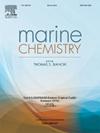在开阔的南大西洋,颗粒铁在冬季和春季之间的季节性主要是由非生物过程驱动的
IF 2.5
3区 地球科学
Q2 CHEMISTRY, MULTIDISCIPLINARY
引用次数: 0
摘要
在开阔的南大洋,初级生产力主要受铁浓度限制的驱动。然而,有限的冬季铁数据使我们对季节性如何影响铁循环和初级生产力的理解存在空白。在这种情况下,在春季和冬季,两次巡航沿着南大洋大西洋部分的同一样带,从亚热带区到南极区。本研究旨在确定颗粒铁浓度是否表现出季节性变化,并确定驱动这些变化的过程。春季和冬季颗粒铁浓度分别在0.04 ~ 0.99 nM和0.04 ~ 1.17 nM之间,地表水中颗粒铁浓度最低。总体而言,季节对总pFe分布的影响并不一致,当存在差异时,冬季总pFe浓度高于春季。我们的研究结果表明,生物颗粒铁在春季高于冬季,并且在两个季节只占地表水总pFe的一小部分。因此,生物过程不能解释观测到的全氟化铁浓度的季节变化。在某些站点,冬季的pFe浓度高于春季,似乎与产岩颗粒的偶发性外部输入有关,例如富铁粉尘沉积和来自ACC的输入。自生部分是总pFe的主要贡献者。这些颗粒似乎是由成岩颗粒溶解或热液活动产生的溶解铁的沉淀形成的。本文章由计算机程序翻译,如有差异,请以英文原文为准。
Particulate iron seasonality between winter and spring in the open Southern Atlantic Ocean is primarily driven by non-biological processes
In the open Southern Ocean, primary productivity is mainly driven by limiting concentrations of iron. However, limited available iron data during winter leave a gap in our understanding of how seasonality affects the iron cycle, and primary productivity. In this context, two cruises followed the same transect in the Atlantic sector of the Southern Ocean, from the SubTropical zone to the Antarctic zone, during spring and winter. This study aims to determine whether particulate iron concentrations showed seasonal changes, and to identify the processes driving these variations. Particulate iron ranged between 0.04–0.99 nM and 0.04–1.17 nM during spring and winter, respectively, with the lowest concentrations measured in surface waters. Overall, seasonality did not consistently affect total pFe distributions, and when differences existed, total pFe concentrations were higher in winter than in spring. Our findings indicate that biogenic particulate iron is higher in spring than in winter, and represents only a minor component of total pFe in surface waters during both seasons. Therefore, biological processes do not account for the observed seasonal changes in total pFe concentrations. At certain stations, higher pFe concentrations in winter relative to spring appear to be related to episodic external inputs of lithogenic particles, such as iron-rich dust deposition and inputs from the ACC. The authigenic fraction is the primary contributor to total pFe. These particles seem to be formed through the precipitation of dissolved iron derived from the dissolution of lithogenic particles or hydrothermal activity.
求助全文
通过发布文献求助,成功后即可免费获取论文全文。
去求助
来源期刊

Marine Chemistry
化学-海洋学
CiteScore
6.00
自引率
3.30%
发文量
70
审稿时长
4.5 months
期刊介绍:
Marine Chemistry is an international medium for the publication of original studies and occasional reviews in the field of chemistry in the marine environment, with emphasis on the dynamic approach. The journal endeavours to cover all aspects, from chemical processes to theoretical and experimental work, and, by providing a central channel of communication, to speed the flow of information in this relatively new and rapidly expanding discipline.
 求助内容:
求助内容: 应助结果提醒方式:
应助结果提醒方式:


